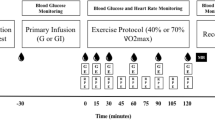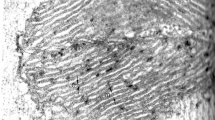Abstract
This report describes the effects of 9 weeks of endurance-training on the relative rates of lactate removal via oxidation and gluconeogenesis in humans. Before and after training, eight subjects performed incremental (60 W plus 40 W every 6 min) exercise tests, while14C-lactate was infused into one forearm vein and “arterialized” venous blood was sampled from the other forearm. During the trial, the volume of expired14CO2 and circulating14C-lactate and14C-glucose specific radioactivities were measured. Such measurements revealed that training increased the estimated oxidation of equivalent venous blood lactate concentrations [VLa] of greater than 1.6 mmol/l. These increases in lactate oxidation were more than would be predicted from the approximately 40% higher O2 uptake values at any [VLa] after training. At a [VLa] of 6 mmol/l, rates of lactate oxidation were increased by some 100% following training, from 105±12 to 208±33 μmol/min/kg (P<0.01). Improvements in lactate oxidation after training reduced the estimated rates of lactate-to-glucose conversion from 40±3 to 9±2 μmol/min/kg at a [VLa] of 2.5 mmol/l (P<0.01). Thus, unlike in rats, human endurance-training does not increase gluconeogenesis. In the final stages of progressive exercise after training, more than 80% of lactate was oxidised and accounted for approximately 45% of overall carbohydrate oxidation.
Similar content being viewed by others
References
Ahlborg G, Felig P (1982) Lactate and glucose exchange across the forearm, legs and splanchnic bed during and after prolonged leg exercise. J Clin Invest 69:45–54
Bobyleva-Guarriero A, Lardy Ha (1986) The effect of different types of physical exercise on glucose and citrulline synthesis in isolated liver parenchymal cells. FEBS Lett 194:56–59
Bosch AN, Dennis SC, Noakes TD (1993) Underestimation of substrate oxidation during exercise due to a failure to account for bicarbonate kinetics-reply. J Appl Physiol 75:2341–2343
Brooks GA (1986) The lactate shuttle during exercise and recovery. Med Sci Sports Exerc 18:360–368
Carlsten AB, Hallgren B, Jagenburg R, Svanborg A, Werko L (1961) Myocardial metabolism of glucose, lactic acid, amino acids and fatty acids in healthy human individuals at rest and at different workloads. Scand J Clin Lab Invest 13:418–428
Coggan AR, Kohrt WM, Spina RJ, Bier DM, Holloszy JO (1990) Endurance training decreases plasma glucose turnover and oxidation during moderate-intensity exercise in men. J Appl Physiol 68:990–996
Consolazio CR, Johnson RE, Pecora LT (1963) Physiological measurements of metabolic function in man. McGraw New York
Depocas R, Minaire Y, Chatonnet J (1969) Rates of formation and oxidation of lactic acid in dogs at rest and during moderate exercise. Can J Physiol Pharmacol 47:603–610
Dohm GL, Kasperek GJ, Barakat HA (1985) Time course of changes in gluconeogenic enzyme activities during exercise and recovery. Am J Physiol 12:E6-E11
Donovan CM, Brooks GA (1983) Endurance training affects lactate clearance, not lactate production. Am J Physiol 244:E83-E92
Donovan CM, Sumida KD (1990) Training improves glucose homeostasis in rats during exercise via glucose production. Am J Physiol 258:R770-R776
Dubowitz V, Brooke M (1973) Muscle biopsy: a modern approach. Saunders, Philadelphia
Foster DW (1984) From glycogen to ketones — and back. Diabetes 33:1188–1199
Freminet A, Minaire Y (1984) On the use of isotopic tracers for the study of lactate metabolism in vivo. Med Sport Sci 17:25–39
Galbo H, Saugmann P, Richter EA (1979) Increased hepatic glycogen synthetase and decreased phosphorylase in trained rats. Acta Physiol Scand 107:269–272
Gertz EW, Wisneski JA, Neese R, Bristow JD, Searle GL, Hanlon JT (1981) Myocardial lactate metabolism:evidence of lactate release during net chemical extraction in man. Circulation 63:1273–1279
Holloszy JO, Coyle EF (1984) Adaptations of skeletal muscle to endurance exercise and their metabolic consequences. J Appl Physiol 56:831–838
Huston RL, Weiser PC, Dohm GL, Askew EW, Boyd JB (1975) Effects of training, exercise and diet on muscle glycolysis and liver gluconeogenesis. Life Sci 17:369–376
Issekutz B (1984) Effect ofβ-adrenergic blockade on lactate turnover in exercising dogs. J Appl Physiol 57:1754–1759
Issekutz B, Shaw WAS, Issekutz AC (1976) Lactate metabolism in resting an exercising dogs. J Appl Physiol 40:312–319
Katz J, McGarry JD (1984) The glucose paradox: is glucose a substrate for liver metabolism? J Clin Invest 74:1901–1909
Lehman SL, Brooks GA (1990) Obtaining a representative blood sample in lactate tracer studies. Horm Metab Res 22:470–477
MacRae HS-H, Dennis SC, Bosch AN, Noakes TD (1992) The effects of training on lactate production and removal during progressive exercise in humans J Appl Physiol 72:1649–1656
Mazzeo RS, Brooks GA, Schoeller DA, Budinger DF (1986) Disposal of blood [1-13C] lactate in humans during rest and exercise. J Appl Physiol 60:232–241
Newgard CB, Hirsch LJ, Foster DW, McGarry JD (1983) Studies on the mechanism by which exeogenous glucose is converted into liver glycogen in the rat: a direct or indirect pathway. J Biol Chem 258:8046–8052
Rocher L, Kirsch KA, Stroboy H (1976) Plasma volume, albumin and globulin concentrations and their intravascular masses. Eur J Appl Physiol 36:67–64
Rowell LB (1986) Human circulation regulation during physical stress. Oxford University Press, New York
Sahlin K (1987) Lactate production cannot be measured with tracer techniques. Am J Physiol 252:E439-E440
Scherrer S, Haldimann B, Kupfer A, Reubi F, Bircher J (1978) Hepatic metabolism of aminopyrine in patients with chronic renal failure. Clin Sci Mol Med 54:133–140
Stanley WC, Gertz EW, Wisneski JA, Morris DL, Neese RA, Brooks GA (1985) Systemic lactate kinetics during graded exercise in man. Am J Physiol 249:E595-E602
Stanley WC, Gertz EW, Wisneski JA, Neese RA, Morris DL, Brooks GA (1986) Lactate extraction during net lactate release in legs of humans during exercise. J Appl Physiol 60:116–1120
Stanley WC, Wisneski JA, Gertz EW, Neese RA, Brooks GA (1988) Glucose and lactate interrelations during moderate-intensity exercise in humans. Metabolism 37:850–858
Steele R (1959) Influence of glucose loading and of injected insulin on hepatic glucose output. Ann NY Acad Sci 82:420–430
Author information
Authors and Affiliations
Rights and permissions
About this article
Cite this article
MacRae, H.H.S., Noakes, T.D. & Dennis, S.C. Effects of endurance training on lactate removal by oxidation and gluconeogenesis during exercise. Pflugers Arch. 430, 964–970 (1995). https://doi.org/10.1007/BF01837410
Received:
Revised:
Accepted:
Issue Date:
DOI: https://doi.org/10.1007/BF01837410




